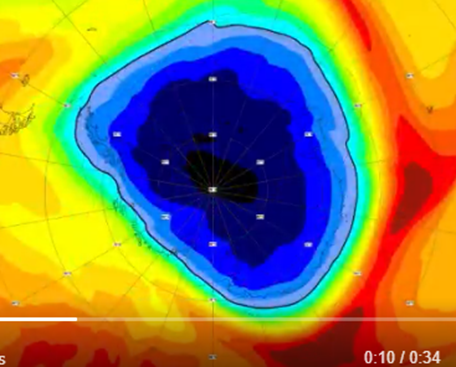Remember the ‘80s? The Cars, The Police, Talking Heads, the end of Disco (thank the Good Lord), the beginning of greed (actually, it started much earlier), the invention of the PC, and … the Ozone Hole? Nobody seems to talk about ozone any more, with headlines dominated by CO2 and Climate Change. But, the seasonal hole in the ozone layer hasn’t gone away. Why should you care? Ozone in the stratosphere helps filter out the harmful ultraviolet spectrum of solar radiation, a known cause of skin cancer and damage to the eyes.

There’s good news, though … sort-of. The Montreal Protocol, adopted worldwide in 1987 to phase out the production of Chlorinated Fluorocarbons (CFCs, like R-12) and Hydrochlorofluorocarbons (HCFCs, like R-22) as refrigerants, seems to have been effective in reducing the atmospheric concentration of chlorine compounds and other “ozone-depleting substances” (ODSs). The most recent major report of the scientists studying ozone, released in 2018, says that in the upper atmosphere there are “emerging indications that the Antarctic ozone hole has diminished in size and depth,” likely explained by declining ODSs and upper stratospheric cooling caused by carbon dioxide increases. Wait, what? Increasing CO2 concentration is helping replenish the ozone layer? Why isn’t that part of the current climate debate in the media? To be sure, the atmosphere is a complex system and whenever we do things that have measurable effects on its composition, we’re bound to see effects that we don’t expect. I’m not going to pretend to explain the interactions; I’ll leave it to the scientists. They admit that there are a lot of variables like volcanic eruptions that they can’t predict, and they haven’t been able to measure a statistically significant increase in global “total column ozone” between 1997 and 2016. However, their models suggest that if we stick with the Montreal protocol, atmospheric ozone should be back to 1980 levels by 2050.
Of more immediate interest is the effect of Montreal on our air conditioners. The refrigerants R-12 (dichlorodifluoromethane) and R-22 (chlorodifluoromethane) were widely used in air conditioners and heat pumps prior to Montreal, and their production was phased out as a result of Montreal. To replace them, we initially had R-134a (1,1,1,2-Tetrafluoroethane), an HFC, which is also being phased out due to its global warming potential, and now R-410a or R-1234yf and others which have much lower global warming and ozone-depleting effects But you can’t just swap refrigerants, the equipment needs to be designed for it. The problem is these new refrigerants are both less effective than the ones they replaced (refrigerators and heat pumps are typically less efficient) and most of them operate at higher pressures, making the associated equipment both less reliable and more dangerous to work on. The result is we have to consume more electricity for the same cooling effect … which adds to CO2 release and global warming. Go figure. And, if we don’t spend more money on qualified technicians to maintain our equipment, we’re going to have to replace our AC units more frequently (with more costly equipment), costing us LOTS more money. The powers-that-be have determined that this impact is less problematic than the release of the older refrigerants into the atmosphere.
Some good news: manufacturers are developing equipment for new refrigerants that are more energy-efficient and less harmful to the environment. Examples: R-32, R-600A. Actually, R-600A is simply iso-butane … a hydrocarbon fuel! Yes, it will burn nicely if it leaks near an ignition source.
What you should do:
- If you have a really old refrigerator or AC unit with R-12 or R-22, maintain it to keep it running if it’s working well … but if it’s not working well, you have limited options to fix it. The remaining stock of these refrigerants is limited and expensive. Check with a reputable HVAC technician.
- If you decide to dispose of equipment containing R-12 (or any refrigerant, for that matter), don’t just toss it in the landfill. The R-12 is valuable and if it’s not already leaked out, there are companies that will recover it and prevent its release into the atmosphere.
- If you have newer equipment with the new refrigerants, it’s worth spending a little money each year on a “tune-up” with a qualified HVAC technician to make sure it’s in good condition and isn’t leaking refrigerant. And make sure you change the filters regularly to keep it running at peak efficiency. If you notice your AC unit running more frequently or for longer periods of time, it’s a clue that it needs attention.
- Look for the next report from the World Meterological Association (published by NOAA) in 2022. Hopefully it will show data with an upward trend in the total atmospheric ozone.
#ozonehole #ozone #refrigerant #energy #CFC #climatechange #climateaction #climatechangeisreal #climatedebate

awesome post thanks